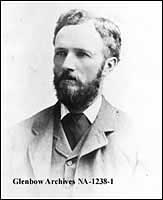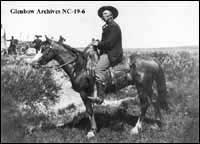Oxley Ranch
 It is difficult to say how accurately John R. Craig tells the history of the Oxley Ranch. In
Ranching with Lords and Commons, published in 1903, the former manager of the ranch near Ft. Macleod writes less about the animals than about his often rocky relationship with the company’s investors. It is difficult to say how accurately John R. Craig tells the history of the Oxley Ranch. In
Ranching with Lords and Commons, published in 1903, the former manager of the ranch near Ft. Macleod writes less about the animals than about his often rocky relationship with the company’s investors.
John R. Craig was born in Ontario in 1837. For many years he farmed successfully in Ontario, where he specialized in raising Shorthorn cattle and Berkshire hogs. In December of 1875, he sold his entire stock of Shorthorns for a considerable sum and invested the capital in what he named the Dominion Livestock Company of Canada. In 1881, he applied for and received a lease of 100,000 acres in the new North West Territory.
 After raising a modest amount of capital with the help of his own colleagues, Craig traveled to London to enlist the support of the influential politician, lawyer, and traveler Alexander Staveley Hill. But Hill was
wary; the plans looked promising, but he would only invest with men of his own acquaintance. Craig consulted with the other members of his company, and they agreed to withdraw. By 1882, he had found the appropriate investors: the Earl of Lathom, the Lord Chamberlain of England, and Mr. George Baird. Hill was elected managing director, and Craig was appointed resident manager. After raising a modest amount of capital with the help of his own colleagues, Craig traveled to London to enlist the support of the influential politician, lawyer, and traveler Alexander Staveley Hill. But Hill was
wary; the plans looked promising, but he would only invest with men of his own acquaintance. Craig consulted with the other members of his company, and they agreed to withdraw. By 1882, he had found the appropriate investors: the Earl of Lathom, the Lord Chamberlain of England, and Mr. George Baird. Hill was elected managing director, and Craig was appointed resident manager.
Craig set up the first headquarters of Oxley Ranch (named after Hill’s country home) in a cabin built by former whiskey trader Hentry Kountz, thirty miles north of Ft. Macleod. He then hired Kountz as ranch cook.
 In November, Hill and Craig acquired the rights to a ranch in Montana for
$5,000. With the purchase of the three adjacent leases of land, they brought their total number of stock to 3,500. But Hill, according to Craig, was reluctant to pay for his purchases, and Craig was forced to take out personal loans from the American I.G. Baker Company, and even sell some cattle to a neighbouring rancher. By the winter of 1883-84, all debts had been paid off, and the company held 200,000 acres of land, 3,000 cattle, and 300 horses. In November, Hill and Craig acquired the rights to a ranch in Montana for
$5,000. With the purchase of the three adjacent leases of land, they brought their total number of stock to 3,500. But Hill, according to Craig, was reluctant to pay for his purchases, and Craig was forced to take out personal loans from the American I.G. Baker Company, and even sell some cattle to a neighbouring rancher. By the winter of 1883-84, all debts had been paid off, and the company held 200,000 acres of land, 3,000 cattle, and 300 horses.
But more financial worries were in store. Hill wanted more cattle, but he wanted them on credit, which he then rarely paid off. Craig, caught between investors on one side and creditors on the other, tried in vain to appease them both: in October, 1885, the
Macleod Gazette reported that Hill’s nephew, Stanley Pinhorne, had usurped Craig’s managerial duties. Craig was summoned to London, where the investors charged him with mismanagement. He had refused to
send the profits from some recently sold steers to London while the ranch still owed creditors in Montana and the Northwest. Craig returned to Canada without his job, and it wasn’t until 1890 that he could legally lay claim to a piece of the land formerly owned by the Oxley Ranch Company. Pinhorne’s was a more tragic
fate - he was found dead on October 1892, a discharged pistol in his right hand.
The Oxley Ranch was purchased by William Roper Hull in 1903.
|

|



